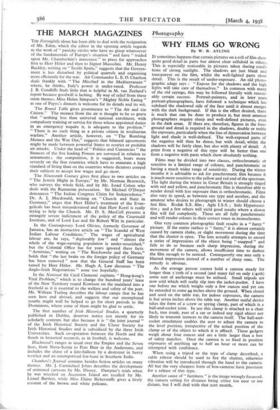Photography
WHY FILMS GO WRONG
By W. R. AYLING
Jr sometimes happens that certain pictures on a roll of film show quite good detail in parts but almost clear celluloid in others. This is especially noticeable in pictures taken during condi- tions of strong sunlight. The shadows are just blank and transparent on the film, whilst the well-lighted parts show detail. This is the result of under-exposure. An old photo- graphic adage says : " Expose for the shadows and the high lights will take care of themselves." In common with many of the old sayings, this may be followed literally with reason- ably certain success. Portrait-painters, and in later years portrait-photographers, have followed a technique which has subdued the shadowed side of the face until it almost merges with the dark background. If this is the effect desired, there is much that can be done to produce it, but most amateur photographers require sharp and well-defined pictures, even in the dark areas. If there are, therefore, figures in the fore- ground and detail is required in the shadows, double or treble the exposure, particularly when the line of demarcation between light and shade is well-defined. The well-exposed parts of the negative will then be dense, but with detail, whilst the shadows will be fairly clear, but also with plenty of detail. A print from a negative of this type will be better than one from a negative with parts which show absolutely nothing Films may be divided into two classes, orthochromatic or sensitive to a limited range of colours, and panchromatic or having a much wider range of sensitivity. During the winter months it is advisable to ask for panchromatic film because it is much more sensitive to the yellow and red end of the spectrum. The light during the winter in Great Britain is strongly tinged with red and yellow, and panchromatic film is therefore able to render detail with less exposure than is orthochromatic. Films also vary in speed, as between one type and another, and the amateur who desires to photograph in winter should choose a fast film. Kodak S.S. film ; Agfa I.S.S. ; Selo Hypersensi- tive ; and a few others will yield good results where a slower film will fail completely. These are all fully panchromatic and will render colours in their correct tones in monochrome.
One very common photographic fault results in a " fuzzy " picture. If the entire surface is " fuzzy," it is almost certainly caused by camera shake, or slight movement during the time that the shutter is open. The lens actually attempts to record a series of impressions of the object being " snapped " and fails to do so because each sharp impression, during the movement of the camera, allows insufficient time to darken the film enough to be noticed. Consequently one sees only a blurred impression instead of a number of sharp ones. The remedy is obvious.
As the average person cannot hold a camera steady for longer than t; loth of a second (and many fail on only !Moth) some sort of anchorage must be utilised. Small tripods are now sold which will really slip into the jacket-pocket. I have one before me which weighs only a few ounces and yet can be extended to some 44 inches above the ground. When closed and used on the table top, for indoor exposures, the camera is but seven inches above the table top. Another useful device takes the form of a screw or spring clamp, part of which is a ball-and-socket joint. In use this clamp is attached to a chair back, tree trunk, part of a car or indeed any rigid object not likely to transmit tremors to the camera itself. The ball-and- socket attachment enables the user to adjust the camera to the level position, irrespective of the actual position of the clamp or of the object to which it is affixed. These gadgets weigh about four ounces and are a little larger than a box of safety matches. Once the camera is so fixed in position exposures of anything up to half an hour or more can be attempted with confidence.
When using a tripod or the type of clamp described, a cable release should be used to fire the shutter, otherwise vibration will be introduced through the hand to the camera. All but the very cheapest form of box-cameras have provision for a release of this type.
Another cause of " fuzziness " is the image wrongly focussed, the camera setting for distance being either too near or too distant, but I will.deal with that next month.






































































 Previous page
Previous page